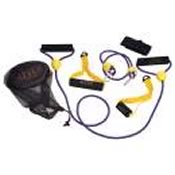 You hear about them. You see people using them in the gym. They’re in stores, on TV, and have entire fitness classes designed around them. You think about these stretchy bands and what good (if any) they do. You want to know: What are the benefits of training with resistance bands?
You hear about them. You see people using them in the gym. They’re in stores, on TV, and have entire fitness classes designed around them. You think about these stretchy bands and what good (if any) they do. You want to know: What are the benefits of training with resistance bands?Everyone from beginners to conditioned athletes can benefit by adding resistance tubes/bands to their strength-training programs. Resistance bands can add challenge and variety to any workout program, and they come in a convenient (and affordable) little package. VARIETY To consistently see gains from a training program, and avoid hitting a plateau, it is essential that you are always varying your workout. This means alternating machine exercises, barbells, and dumbbells, and adding other elements like stability balls and resistance bands. The reason for this is simple: your body is smart & adaptable. Do the same exercises (same movements, same Range Of Motion, same angles) over and over, and the body is no longer challenged. It becomes efficient, and you no longer see gains. The training possibilities of resistance bands are endless. They allow you to move more freely and achieve a greater range of motion (as opposed to a machine which controls where you start and stop). This allows you to create resistance from all directions—the side, overhead, below, etc. You can also adjust your angle of movement (by moving the fixed point higher or lower), and combine several exercises seamlessly. Bands also allow you to mimic movements that you do in real life. If you want to improve your golf or tennis swing, you can perform that exact motion against resistance—no machine can do that. Bands can also be used alone (standing on a tube and doing a bicep curl, for example), or in combination with other elements that add even more challenge to your workout: stability balls, steps, Bosu balls, and wall mounts. Resistance bands also differ in their degree of difficulty (signaled by various colors). The most stretchable bands have lighter resistance than the harder-to-stretch ones that offer heavier resistance. This, along with body position, allows you to customize the level of resistance to fit your strength level. You control the tension by shortening or lengthening the band. For example, when standing on a band to perform a bicep curl, add resistance by stepping closer to the handle, or make it lighter by stepping away from it. CONVENIENCE You can work every muscle in your body by using resistance bands. Moreover, you can easily use them anywhere. They’re lightweight and take up hardly any space, making them easy to travel with or use at home, or even behind your desk at work. You can wrap a band around a doorknob, pole, chair, your ankle (for leg exercises) or almost any stable object. Plus, you can adjust the amount of resistance in seconds, quickly moving from one exercise to the next. Continued › |
No Need to Stretch the Truth about Resistance Bands
Add Variety, Convenience & Affordability to your Pregnancy Workout
Page 1 of 2 Next Page ›






Member Comments